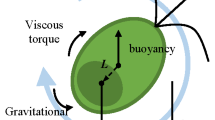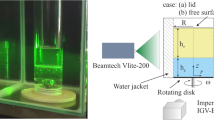Abstract
The behavior of collections of oceanic bacteria is controlled by metabolic (chemotaxis) and physical (fluid motion) processes. Some sulfur-oxidizing bacteria, such as Thiovulum majus, unite these two processes via a material interface produced by the bacteria and upon which the bacteria are transiently attached. This interface, termed a bacterial veil, is formed by exo-polymeric substances (EPS) produced by the bacteria. By adhering to the veil while continuing to rotate their flagella, the bacteria are able to exert force on the fluid surroundings. This behavior induces a fluid flow that, in turn, causes the bacteria to aggregate leading to the formation of a physical pattern in the veil. These striking patterns are very similar in flavor to the classic convection instability observed when a shallow fluid is heated from below. However, the physics are very different since the flow around the veil is mediated by the bacteria and affects the bacterial densities.
In this study, we extend a model of a one-dimensional veil in a two-dimensional fluid to the more realistic two-dimensional veil in a three-dimensional fluid. The linear stability analysis indicates that the Peclet number serves as a bifurcation parameter, which is consistent with experimental observations. We also solve the nonlinear problem numerically and are able to obtain patterns that are similar to those observed in the experiments.
Similar content being viewed by others
References
Batchelor, G., 1967. An Introduction to Fluid Dynamics. Cambridge University Press, Cambridge.
Berglen, T.F., Berntsen, T.K., Isaksen, I.S.A., Sundet, J.K., 2004. A global model of the coupled sulfur/oxidant chemistry in the troposphere: The sulfur cycle. J. Geophys. Res. 109, 1–27.
Blake, J.R., 1971. A note on the image system for a stokeslet in a no-slip boundary. Proc. Camb. Philos. Soc. 70, 33310.
Cogan, N.G., Wolgemuth, C.W., 2005. Pattern formation by bacteria-driven flow. Biophys. J. 88, 2525–2529.
Cortez, R., 2001. The method of regularized stokeslets. SIAM J. Sci. Comput. 23, 1204–1225.
Fenchel, T., Glud, R.N., 1998. Veil architecture in a sulphide-oxidizing bacterium enhances countercurrent flux. Nature 394, 367–369.
Gradshteyn, L.S., Ryzhik, L.M., 1980. Table of Integrals, Series, and Products. Academic Press, New York.
Lorenz, H.A., 1907. Ein allgemeiner satz, die bewegung einer reibenden flussugkeit betreffend, nebst einigen anwendungen desselben, abhand. Theor. Phys. 1, 23–42.
Muyzer, G., Yildirim, E., van Dongen, U., Kühl, M., Thar, R., 2005. Identification of “Candidatus Thioturbo danicus,” a microaerophilic bacterium that builds conspicuous veils on sulfidic sediments. Appl. Environ. Microbiol. 71, 8929–8933.
Pozrikidis, C., 1992. Boundary Integral and Singularity Methods for Linearized Viscous Flow. Cambridge University Press, Cambridge.
Sass, A., Eschemann, A., Kühl, M., Thar, R., Sass, H., Cypionka, H., 2002. Growth and chemosensory behavior of sulfate-reducing bacteria in oxygen-sulfide gradients. FEMS Microbiol. Ecol. 40, 47–54.
Thar, R., Fenchel, T., 2001. True chemotaxis in oxygen gradients of the sulfur-oxidizing bacterium Thiovulum majus. Appl. Environ. Microbiol. 67, 3299–3303.
Thar, R., Kühl, M., 2002. Conspicuous veils formed by vibrioid bacteria on sulfidic marine sediment. Appl. Environ. Microbiol. 68, 6310–6320.
Thar, R., Kühl, M., 2003. Bacteria are not too small for spatial sensing of chemical gradients: An experimental evidence. Proc. Natl. Acad. Sci. USA 100, 5748–5753.
Thar, R., Kühl, M., 2006. Complex pattern formation of marine gradient bacteria explained by a simple computer model. FEMS Microbiol. Lett. 246, 75–79.
Author information
Authors and Affiliations
Corresponding author
Rights and permissions
About this article
Cite this article
Cogan, N.G., Wolgemuth, C.W. Two-Dimensional Patterns in Bacterial Veils Arise from Self-generated, Three-Dimensional Fluid Flows. Bull. Math. Biol. 73, 212–229 (2011). https://doi.org/10.1007/s11538-010-9536-1
Received:
Accepted:
Published:
Issue Date:
DOI: https://doi.org/10.1007/s11538-010-9536-1




